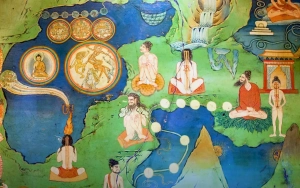
Across the globe, diverse cultures have recognized and revered the concept of a vital life force that sustains and animates all living beings. Known by different names and cultivated through unique practices, this life force is central to physical health, spiritual growth, and overall well-being.
From the “Qi” of Chinese tradition to the “Prana” of Indian yoga, and from the “Mana” of Polynesian culture to the “Orenda” of Native American tribes, the universal quest for harnessing and enhancing this vital energy underscores a shared human endeavor.
The Vital Life Force: A Cross-Cultural Exploration
1. Qi (Traditional Chinese Medicine)
Origin: Chinese tradition
Concept: Qi (pronounced “chee”) is the vital energy that flows through the body’s meridians, sustaining life and health.
Practices: Cultivating Qi involves practices such as acupuncture, herbal medicine, Tai Chi, and Qigong, which aim to balance and enhance the flow of this life force.
2. Prana (Hinduism and Yoga)
Origin: Indian tradition
Concept: Prana is the life force or vital energy present in all living beings. It is fundamental to physical and spiritual well-being.
Practices: Yoga, pranayama (breath control), meditation, and Ayurvedic practices are used to cultivate and balance Prana.
3. Kundalini (Indian Spirituality)
Origin: Indian tradition
Concept: Kundalini is a form of primal energy said to be coiled at the base of the spine. When awakened, it rises through the chakras, leading to heightened awareness and spiritual enlightenment.
Practices: Kundalini yoga, meditation, breath control, and spiritual practices aim to awaken and guide this energy upwards through the body’s energy centers.
4. Mana (Polynesian and Melanesian Cultures)
Origin: Indigenous Polynesian and Melanesian cultures
Concept: Mana is a supernatural force or spiritual energy that resides in people, animals, and objects.
Practices: Rituals, chants, and a deep respect for nature are employed to enhance and maintain Mana.
5. Ase (Yoruba and Afro-Caribbean Religions)
Origin: Yoruba religion, also found in Santería, Candomblé, and other Afro-Caribbean traditions
Concept: Ase (pronounced “ah-shay”) is the life force or divine energy that permeates the universe and is present in all living things.
Practices: Rituals, offerings, music, dance, and invocations are used to harness and direct Ase.
6. Orenda (Iroquois and other Native American Tribes)
Origin: Iroquois and other Native American tribes
Concept: Orenda is a spiritual force present in all objects, living or non-living.
Practices: Ceremonies, chants, and a deep respect for the natural world enhance Orenda.
7. Baraka (Islamic Mysticism and Sufism)
Origin: Islamic mysticism, particularly Sufism
Concept: Baraka is a spiritual presence or blessing that flows from God through saints and holy places.
Practices: Prayer, meditation, dhikr (remembrance of God), and visiting shrines cultivate Baraka.
8. Ruach (Judaism)
Origin: Jewish tradition
Concept: Ruach, often translated as “spirit” or “breath,” refers to the divine spirit or life force from God.
Practices: Prayer, meditation, study of the Torah, and observance of religious laws and rituals enhance Ruach.
9. Num (San Bushmen of Southern Africa)
Origin: San Bushmen of Southern Africa
Concept: Num is a spiritual energy or potency used in healing and spiritual practices.
Practices: Trance dance, healing rituals, and shamanistic practices harness Num.
10. Great Spirit (Native American Tribes)
Origin: Various Native American tribes
Concept: The Great Spirit is a supreme being or life force that animates the universe.
Practices: Prayer, ceremonies, vision quests, and a deep connection with nature enhance this life force.
11. Sekhem (Ancient Egyptian)
Origin: Ancient Egyptian culture
Concept: Sekhem is a form of life energy or power associated with the gods and the afterlife.
Practices: Rituals, offerings, and practices related to the afterlife and deities cultivate Sekhem.
12. Pneuma (Ancient Greek Philosophy)
Origin: Ancient Greek philosophy and later Christian theology
Concept: Pneuma means “breath” or “spirit” and denotes the vital spirit or life force. In Stoicism, it refers to the active, rational principle that organizes and animates the universe.
Practices: Philosophical contemplation, meditation, and practices aimed at aligning with the rational principles of the cosmos.
13. Psyche (Ancient Greek Philosophy)
Origin: Ancient Greek philosophy
Concept: Psyche means “soul” or “life force.” It is the essence of a living being, responsible for life and rationality.
Practices: Philosophical reflection, moral development, and practices aimed at cultivating the soul’s virtues.
Hara & Dan Tien: Core Concepts in Energy Cultivation
Hara
Origin: Japanese tradition
Concept: Hara refers to the energy center located in the lower abdomen, a few inches below the navel. It is considered the seat of one’s physical and spiritual power.
Practices: In martial arts and traditional medicine, Hara is strengthened through practices such as meditation, breathing exercises, and physical training to enhance one’s stability, focus, and inner strength.
Dan Tien (Dantian)
Origin: Chinese tradition
Concept: Dan Tien, also located in the lower abdomen, is the central reservoir of Qi (vital energy). It plays a crucial role in Taoist practices, Qigong, and Chinese martial arts.
Practices: Cultivating Dan Tien involves breathing exercises, meditation, Tai Chi, and Qigong to gather, store, and circulate Qi throughout the body.
Kundalini
Origin: Indian tradition
Concept: Kundalini is described as a coiled serpent of primal energy located at the base of the spine. When awakened, it ascends through the chakras, leading to spiritual awakening and enlightenment.
Practices: Kundalini yoga, meditation, breath control, and specific spiritual practices aim to awaken and guide this energy upwards through the body’s energy centers.
Hara and Dan Tien are pivotal in their respective traditions, embodying the principle of a central life force that must be nurtured and balanced for optimal health and spiritual well-being. These concepts align closely with the universal practices of cultivating vital energy seen in other cultures.
Potent Herbs and Substances for Cultivating Life Force
In addition to the various cultural practices for cultivating life force, numerous herbs and substances are renowned for their ability to enhance vitality, energy, and overall well-being. Here are some potent herbs and foods known for their life force-enhancing properties:
1. Maca (Lepidium meyenii)
- Origin: Andes Mountains, Peru
- Benefits: Known for boosting energy, stamina, and libido, Maca root also supports hormonal balance and mental clarity. It is considered an adaptogen, helping the body adapt to stress.
2. Red Deer Antler Velvet
- Origin: Traditional Chinese Medicine
- Benefits: Rich in growth factors and collagen, Red Deer Antler Velvet is believed to enhance physical performance, support joint health, and improve immune function. It is also used to promote overall vitality and rejuvenation.
3. Tongkat Ali (Eurycoma longifolia)
- Origin: Southeast Asia
- Benefits: Often called “Malaysian Ginseng,” Tongkat Ali is known for its ability to enhance testosterone levels, boost libido, increase muscle mass, and improve overall energy and endurance.
4. Ginseng (Panax ginseng and Panax quinquefolius)
- Origin: Asia (Panax ginseng) and North America (Panax quinquefolius)
- Benefits: Ginseng is celebrated for its adaptogenic properties, helping to reduce stress, boost energy levels, improve cognitive function, and enhance physical performance.
5. Ashwagandha (Withania somnifera)
- Origin: India (Ayurvedic Medicine)
- Benefits: Known as a powerful adaptogen, Ashwagandha helps to reduce stress, improve sleep quality, enhance endurance, and boost overall vitality and resilience.
6. Rhodiola (Rhodiola rosea)
- Origin: Arctic regions of Europe and Asia
- Benefits: Another adaptogen, Rhodiola is used to combat fatigue, enhance mental performance, reduce stress, and improve physical endurance and recovery.
7. Cordyceps (Cordyceps sinensis)
- Origin: Tibetan Plateau
- Benefits: This medicinal mushroom is known for its ability to enhance athletic performance, boost energy levels, support respiratory health, and improve overall vitality.
8. Schisandra (Schisandra chinensis)
- Origin: China (Traditional Chinese Medicine)
- Benefits: Schisandra berries are used to improve liver function, enhance mental clarity, boost energy, and promote overall longevity and resilience.
9. Astragalus (Astragalus membranaceus)
- Origin: China (Traditional Chinese Medicine)
- Benefits: Known for its immune-boosting properties, Astragalus also enhances energy, supports cardiovascular health, and promotes longevity.
10. Holy Basil (Ocimum sanctum)
- Origin: India (Ayurvedic Medicine)
- Benefits: Holy Basil, or Tulsi, is revered for its adaptogenic properties, helping to reduce stress, improve mental clarity, and enhance overall vitality and resilience.
11. Siberian Ginseng (Eleutherococcus senticosus)
- Origin: Russia and Asia
- Benefits: Not a true ginseng, but an adaptogen known for enhancing stamina, reducing fatigue, and improving immune function.
12. Moringa (Moringa oleifera)
- Origin: India and Africa
- Benefits: Moringa leaves are nutrient-dense and known for their antioxidant properties, supporting energy levels, immune function, and overall health.
13. Reishi Mushroom (Ganoderma lucidum)
- Origin: East Asia
- Benefits: Known as the “Mushroom of Immortality,” Reishi supports immune function, reduces stress, improves sleep, and promotes overall vitality and longevity.
These herbs and substances, each with their unique properties, have been used for centuries across different cultures to cultivate life force, enhance vitality, and support overall health and well-being. Incorporating them into one’s lifestyle can provide additional support for physical, mental, and spiritual growth.
The quest for cultivating and harnessing vital life force is a universal human endeavor, transcending cultural and geographical boundaries. Whether referred to as Qi, Prana, Mana, Ase, Orenda, Baraka, Ruach, Num, Sekhem, Pneuma, Psyche, Hara, Dan Tien, or Kundalini, the underlying principle remains the same: enhancing one’s life force leads to improved health, spiritual growth, and overall well-being.
By practicing we can inspire positivity, health, healing, and good fortune, fostering a deeper connection to the vital energy that sustains us all. Understanding and practicing these ancient wisdoms allow us to cultivate our inner strength and resilience, bringing harmony and balance into our lives and communities.
Practice and all is coming. ~ K. Pattabhi Jois




